Table of contents of the article
ToggleThe eastern red hornet is considered an insect that poses a threat to agricultural crops, as it feeds on fruits and causes significant losses. In this article on your website, World of Plants, we will discuss its behavior and ways to combat it.
Symptoms of the eastern red hornet
Scientific name : Vespa orientalis
Type of disease: Insect
the family : Hymenoptera
- Partial or complete biting of ripe grapes
- Corruption of adjacent bunches, which harms the marketing qualities of grapes and increases the possibility of the spread of mold and various fungi.
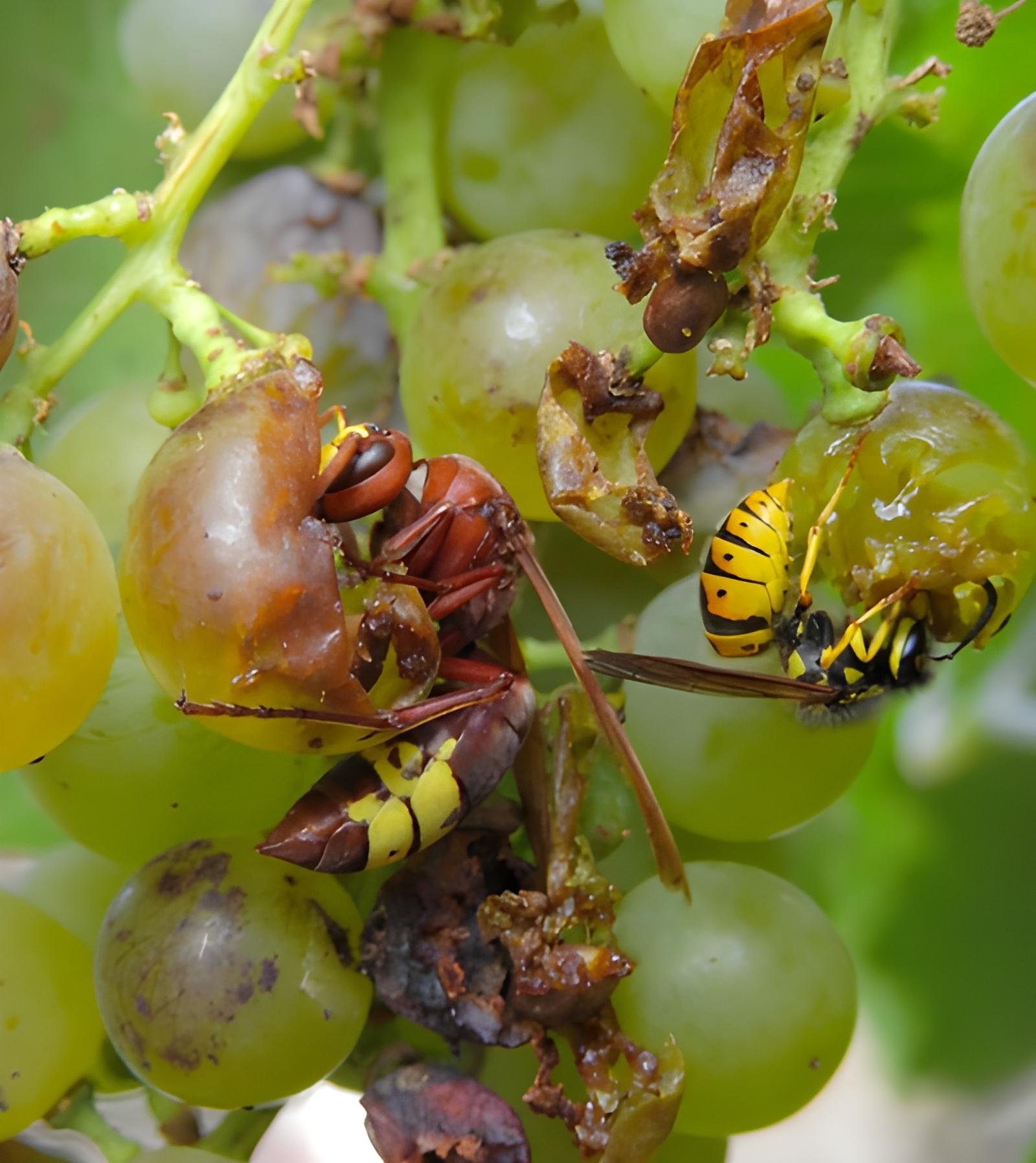
Description of the eastern red hornet
- A medium-sized insect with a clear waist - the color of the insect is reddish brown with yellow spots on the abdominal rings - the compound eyes are black and the forehead with the top of the head is yellow - the antennae are brown - and the insect has three simple eyes on the top of the head Figure
- The larvae are white, spindly, and are located inside the hexagonal eye. They weave a silk cocoon, inside which they transform into the pupal stage
- The virgin is a free type and is white in color.
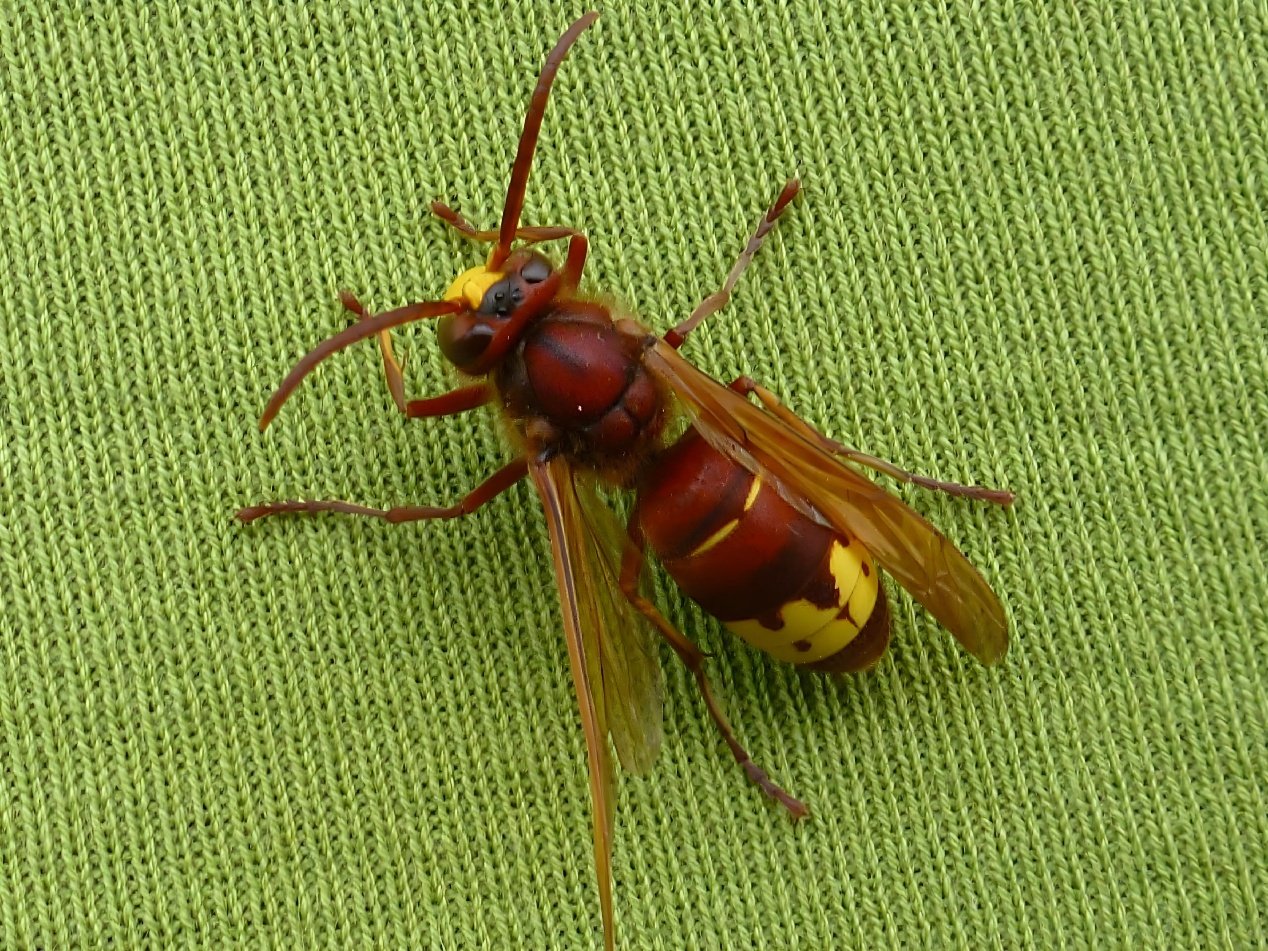
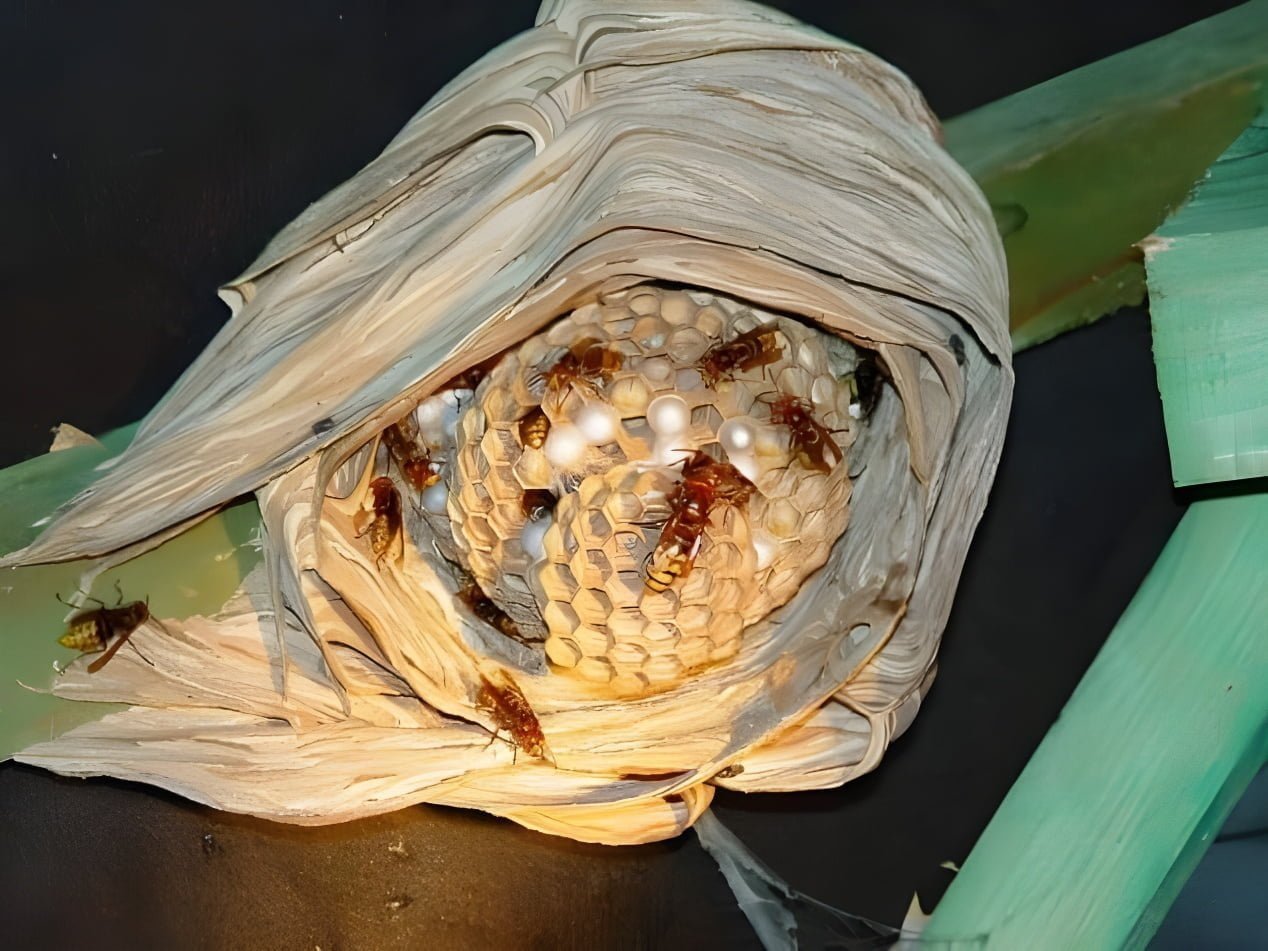
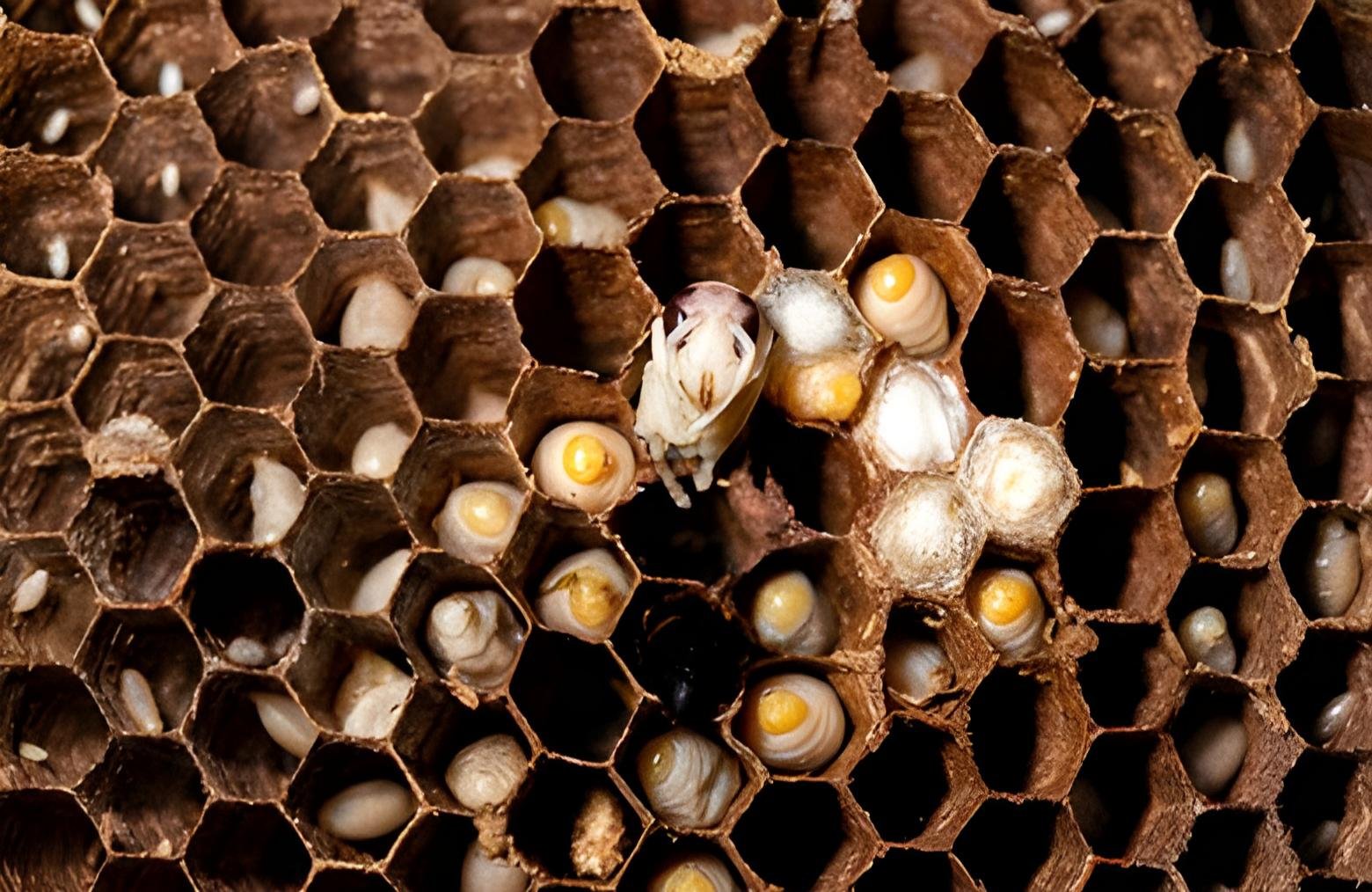
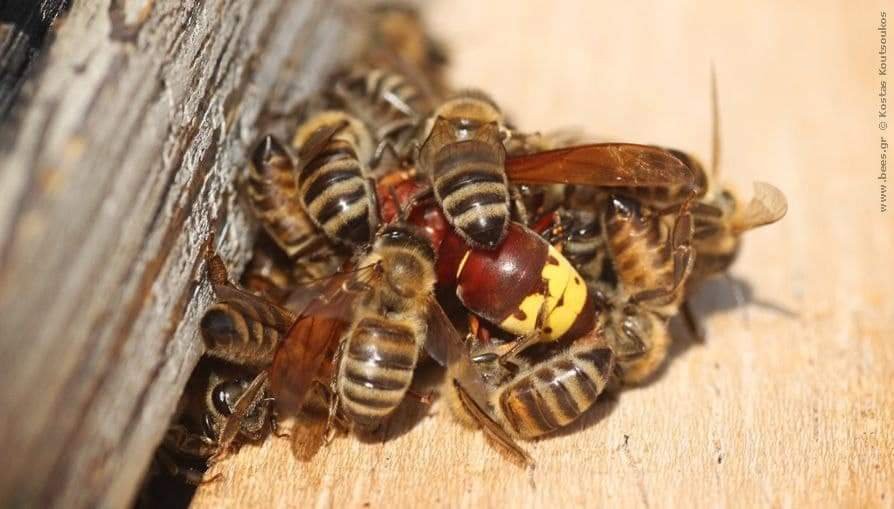
Causes of the eastern red hornet
- Oriental hornets usually live in nests that they dig underground, or they build their nests from tree leaves, pieces of wood, and straw inside protective hollows, such as inside hollow trees, in shipping containers, and in parked and old vehicles.
- Dates attack citrus fruits, so the presence of an infected field transmits the infection to grapes
- The presence of damaged meat.
- The rain stops early, as the warm climate creates a suitable environment for this insect to reproduce
- The wasp obtains sugary substances from various nectar sources in the surrounding environment, such as plant secretions and aphids, or it preys on worker bees.
Suitable conditions for the spread of the eastern red hornet
- The highest suitability values for the insect were predicted to be in warm temperate regions and some arid regions with a humid subtropical, semi-arid or desert climate.
- There is a honey bee hive nearby.
- Neglecting early injury
- The presence of a water source nearby.
Suitable conditions for the spread of the eastern red hornet
Wasps make their nests from soil mixed with saliva so that the cells are oriented, and the nest or colony is one year old.
The insect goes through the winter period in the form of a fertilized queen that emerges from its dormancy in the spring, searching for a suitable place to build a nest and preferring gaps in walls, rocks, and soil.
The queen begins by building the first hexagonal eyes, where she lays the first egg, and so on
After the eggs hatch, food is provided until the workers emerge, who follow and help in developing and building the nest, which may have up to five layers, and the layers are connected to each other by thin appendages made of the same material as the nest.
The life cycle of the worker in the summer takes about 29 days, the queen 42 days, and the male 39 days. The number of workers increases in summer and fall, and in the fall the wasps build new nests with wide eyes, and the eggs produce females and males who mate, so the females become new queens while the males die. As for the fertilized females, they spend the winter in silence until the spring of the year
Losses from the spread of eastern red hornet disease
- It attacks the fruits of agricultural crops after they have matured, causing damage, such as grapes, dates, and others.
- The eastern hornet may sting humans
- The oriental hornet exhibits special defensive behaviors that can lead to an allergic reaction. If there are serious allergy symptoms, seek medical attention immediately.
- Wasps attack beehives to obtain honey or bee insects. The numbers of wasps are usually large, which causes confusion for the bee colony and may ultimately lead to the colony’s migration or death.
Eastern red hornet disease control strategy
Preventive measures to prevent the occurrence of eastern red hornet disease
- Destroying the nests by burning or fogging with BHC after sunset
- Use paper bags around grape bunches to protect them from damage.
- Queens can be caught using rubber bats that hit the queen while she flies and frequent the waterways at the beginning of spring.
Chemical and organic control recommendations
- Organic control :
- The eastern hornet has bird enemies such as the warbird.
- Use intact baits placed inside the nest that contain a sugary substance + a toxic substance such as: lindane, malathion, or sevin.
- Chemical control :
- Use calcium cyanide at the entrance to the nest after sunset
- In the event that the nest is not identified or is difficult to reach, apply 90% laniticide on the feathers or entrails of the chicken and place it in the areas of insect nests, taking into account searching for the queens during the fall during the mating period and killing them.
In conclusion, we would like to note that we, at the world of plants website, offer you all the necessary services in the world of plants, we provide all farmers and those interested in plants with three main services::-
- Artificial intelligence consulting service to help you identify diseases that affect plants and how to deal with them.
- Blog about plants, plant diseases and care of various crops ... You are currently browsing one of her articles right now.
- An application that provides agricultural consultations to clients, as well as a service for imaging diseases and knowing their treatment for free – Click to download the Android version from Google Play Store، Click to download the IOS version from the Apple App Store.
references:-
- Werenkraut, Victoria, Marina Paula Arbetman, and Paula Nilda Fergnani. “The Oriental hornet (Vespa orientalis L.): a threat to the Americas?.” Neotropical Entomology (2021): 1-9
- Zucca, P., Granato, A., Mutinelli, F., Schiavon, E., Bordin, F., Dimech, M., … & Spanjol, K. (2024). The oriental hornet (Vespa orientalis) as a potential vector of honey bee's pathogens and a threat to public health in North‐East Italy. Veterinary Medicine and Science, 10(1), e1310
- Ishay, J. S., Abes, A. H., Chernobrov, H. L., Barenholz-Paniry, V., Parmet, Y., & Fuchs, C. (1995). Building activity and longevity of queenless groups of the Oriental hornet, Vespa orientalis. Bulletin of mathematical biology, 57(3), 441-460
- The Oriental Hornet (Vespa orientalis L.): a Threat to the Americas? – springer
- The oriental hornet (Vespa orientalis) as a potential vector of honey bee’s pathogens – WILEY ONLINE LIBRARY
- Building activity and longevity of queenless groups of the oriental hornet, Vespa orientalis – sciencedirect




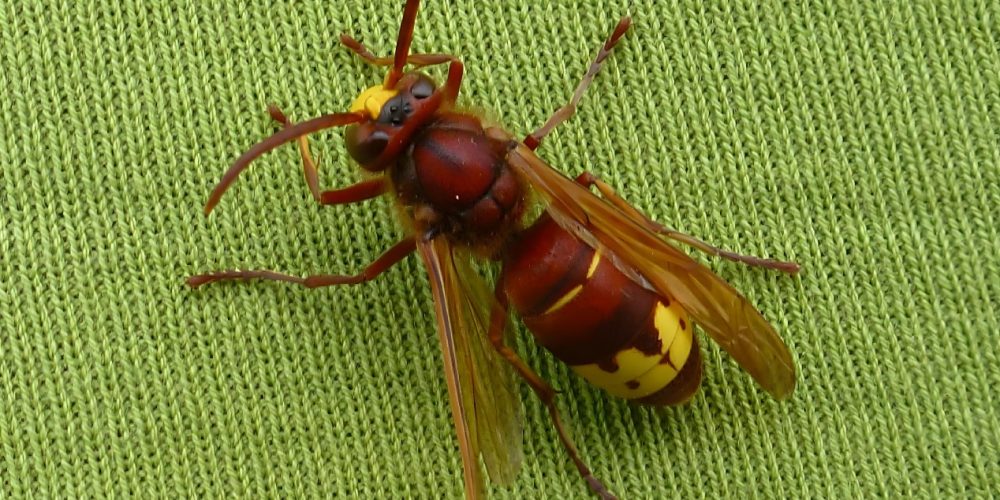
2 Comments
كيف احصل على سم اللنيت وأريد صورة له لان اعشاش الدباببير الحمراء بعيدة بين الجبال ولايمكن العثور عليها الا نادرا
مرحبا بك في عالم النباتات
مكافحة الدبور الأحمر (دبور البلح – الدبور الشرقى – Vespa orientalis):
تتمثل مكافحته فى عدة خطوات هى: –
1-اصطياد الملكات التى تخرج من بياتها الشتوى فى الربيع، وقتلها، ويعد القضاء على ملكة، قضاء على مستعمرة كاملة. وتنجذب هذه الملكات لرائحة المحلول السكرى المتخمر.
2-إذا عرفت أماكن الأعشاش، تحدد فى المساء وتسمم بخلط بعض العسل مع مبيد اللانيت Lannate (طعم سام، وهذا المبيد من أفضل المواد، لهذا الغرض، حيث أنه سم معدى ليست له رائحة) خلطا جيدا، وتغمس فيه ريشة طائر طويلة وتوضع فى فتحة العش. مع اتخاذ إجراءات الأمان، من ارتداء القناع والقفاز والكمامة، وغير ذلك، عند المعاملة. ويمكن مع بعض الاحتياطات، سد فتحة العش بالأسمنت*.
3-استخدام المصائد فى المنحل، ومنها أنواع كثيرة، ويوضع فيها جزء من قرص شمعى بالعسل (أو محلول سكرى مركز) وبعض الدبابير الحية كعوامل جذب، (يوضع جزء من حاجز الملكات لأعلى ليخرج منه النحل الذى قد ينجذب للمصيدة ( وفى هذه الحال لا توضع أية مادة سامة، لحماية النحل).
4-استخدام السمك أو قطع اللحم المسممة (ومنها الفشة أو المعلاج)، بوضعها فى أركان المنحل.
ولا يفضل استخدام المواد الموجودة فى نفس التوقيت، كطعوم أو جاذبات، فمثلا لا يستخدم التمر، وهو موجود على النخيل، أو متوفر فى البيئة، وهذه نقطة مهمة.
5-تضييق مداخل الخلية وإذا استخدم حاجز الملكات، فله بعض العيوب إذ يعيق النحل الجامع لحبوب اللقاح عن الدخول بسهولة، ويتكتل النحل الحارس فى الخارج فيكون عرضة لهجوم الآفة.
6-قتل الدبابير المهاجمة (تكثر فى فصل الخريف) للخلايا باستخدام سباطة البلح.
7-وضع زجاجات ضيقة الفتحات، مثل الخاصة بالمياه الغازية فى أركان المنحل، بعيدا عن الشمس، وبها محلول سكرى متخمر، كمصائد، وهى تنجح مع ذئب النحل أيضا والدبور الأصفر.
8-يدافع النحل بفطرته، عن خليته بمهاجمة الدبور مباشرة، ولسعه وقتله، ولكن فى حال زيادة أعداده لا تنجح هذه الطريقة. ولدى بعض السلالات (فى اليابان) طريقة غاية فى الطرافة، حيث يحيط النحل بالدبور المهاجم، ويحبسه، ويرفع درجة الحرارة بشكل مفاجئ، حوله، فيموت الدبور مسلوقا، وتسمى هذه العملية بالشواء أو السلق Roasting.
9-سد جميع الفتحات والشقوق، إلا فتحات التهوية السلكية، وتغيير أجزاء الخلية التالفة من صناديق وأغطية، وغيرها.
10-حاليا، هناك تجارب لاستخدام الفيرمونات فى المكافحة، وإذا نجحت ستكون من أفضل الوسائل.
بودرة لانيت
مبيد حشري جهازي من مركبات الكرباميت يؤثر بالملامسة وك سم معدى سريع التأثير، شديد السمية إذ يبلغ رقم LD50 17 ملغ/كغ إلا أنه رغم شدة سميته فإن فترة ماقبل الجني للمحاصيل المعاملة تتراوح بين واحد وثلاثين يوماً، فهي في الولايات المتحدة بين يوم إلى ثلاثة أيام حسب نسبة الاستعمال على البندورة والحمضيات والجزر والملفوف، الفاصولياء والبازلاء والخيار، وهي في حدود سبعة أيام على الشعير والثوم والأجص 14 يوم، على الرمان والذرة البيضاء والصويا ثلاثين يوماً على أوراق الشوندر السكري وخس السلطة.
أهم الحشرات التي يكافحها مبيد بودرة لانيت :
ديدان اللوز على القطن والبندورة والذرة والتبغ- حفارات ساق الذرة ، المن، التربس، خنفساء الفصة، الديدان القارضة والخضراء، خنفساء القثاء ، الخنافس البرغوثية، الديدان الناسجة في الحراج، الذبابة البيضاء على الحمضيات وبعض الحشرات القشرية ، ديدان ثمار العنب.
أهم المحاصيل التي يستعمل عليها مبيد بودرة لانيت :
الكوسه، القمح، الفريز، البطاطا، الفول السوداني، الدراق، البصل، البطيخ، الباذنجان، الفليفلة، القرنبيط، التفاح.